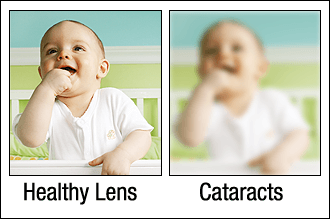
Cataracts are very common, affecting roughly 60% of people over the age of 60, and over 1.5 million cataract surgeries are performed in the United States each year. Advances in cataract surgery has turned it into a 10-15 minutes outpatient procedure where most patients resume normal activities the next day.
A cataract is a loss of transparency, or clouding, of the normally clear lens of the eye. Vision through eyes with cataracts is characterized as looking through a foggy window or piece of wax paper. Cataract development is usually a very gradual process of normal aging, but can occasionally occur rapidly. Many people are unaware that they have cataracts because the changes in their vision are so gradual.As one ages, chemical changes occur in the lens that make it less transparent. The loss of transparency may be so mild vision is hardly affected or so severe that no shapes or movements are seen, only light and dark. When the lens gets cloudy enough to obstruct vision to any significant degree, it is called a cataract. Glasses or contact lenses cannot sharpen your vision if a cataract is present.

The most common cause of cataract is aging. Other causes include trauma, medications such as steroids, systemic diseases such as diabetes and prolonged exposure to ultraviolet light. Occasionally, babies are born with a cataract.
Reducing the amount of ultraviolet light exposure by wearing a wide-brim hat and sunglasses may reduce your risk for developing a cataract but once developed there is no cure except to have the cataract surgically removed. Outpatient surgical procedures can remove the cataract through either a small incision (phacoemulsification) or a large incision (extracapsular extraction). The time to have the surgical procedure is when your vision is bad enough that it interferes with your lifestyle.
Cataract surgery is a very successful operation. One and a half million people have this procedure every year and 95% have a successful result. As with any surgical procedure, complications can occur during or after surgery and some are severe enough to limit vision. But in most cases, vision, as well as quality of life, improves.
Some common symptoms of cataracts may include:
- Painless blurring of vision
- Sensitivity to light and glare
- Double vision in one eye
- Poor night vision
- Fading or yellowing of colors
- Frequent changes in glasses or contact lens prescription.
